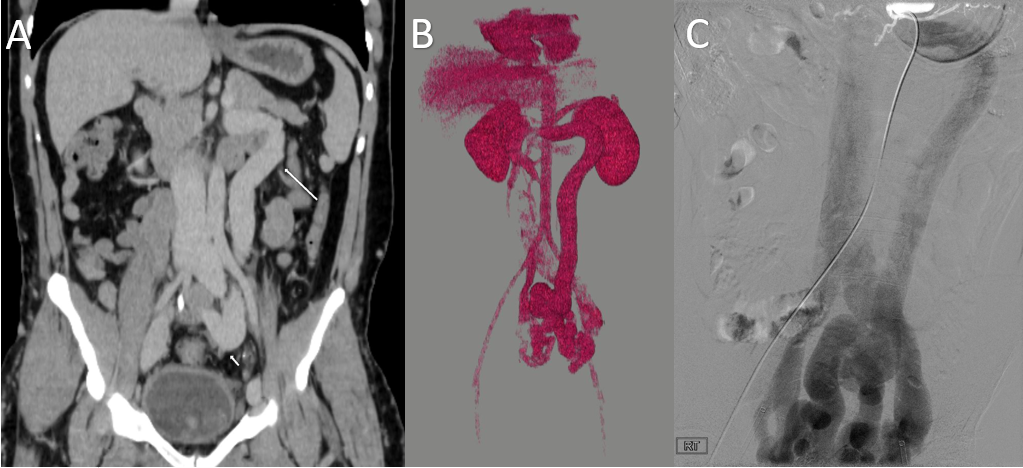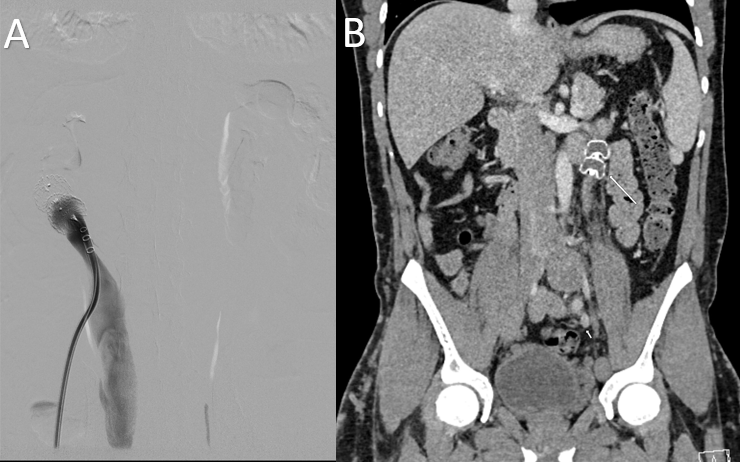Tuesday Poster Session
Category: Liver
P6071 - Use of Dual Watchman for Congenital Portosystemic Shunt Occlusion in a Patient With Klippel-Trenaunay Syndrome: A Case Report
Tuesday, October 28, 2025
10:30 AM - 4:00 PM PDT
Location: Exhibit Hall
.jpeg.jpg)
Ahmed Attia, MD (he/him/his)
Transplant Institute, Department of Surgery, George Washington University School of Medicine and Health Science
Washington, DC
Presenting Author(s)
Award: ACG Presidential Poster Award
Ahmed Attia, MD1, Abdelrhman Refaey, MD2, Mohamed Abdou, MD1, Khaled Elsakka, MD1, Abdalnasir Limay, MD3, Ameer Abutaleb, MD4
1Transplant Institute, Department of Surgery, George Washington University School of Medicine and Health Science, Washington, DC; 2Division of Gastroenterology and Liver Disease, Department of Medicine, George Washington University School of Medicine and Health Sciences, Washington, DC; 3Department of Radiology, The George Washington University Hospital, Washington, DC; 4The George Washington Transplant Institute, Department of Surgery, The George Washington University Hospital, Washington, DC
Introduction: Congenital portosystemic shunts (CPSS) are rare vascular anomalies in which portal blood bypasses the liver and drains directly into the systemic circulation. Abernethy malformations are distinct CPSS subtypes with unique management challenges. Klippel-Trenaunay Syndrome (KTS) is a congenital vascular disorder characterized by capillary malformations, venous varicosities, and limb overgrowth. Coexistence with CPSS, especially Abernethy type II, is exceedingly rare. We present a case of KTS and a large Abernethy type II shunt who underwent successful transvenous embolization using dual watchman (left atrial appendage occluder devices).
Case Description/
Methods: A 32-year-old man with lifelong history of left lower extremity swelling, superficial varicosities, and recurrent thromboembolic episodes, consistent with Klippel-Trenaunay Syndrome (KTS), presented with recurrent spontaneous hemorrhage from varicosities requiring multiple aspiration and suture control which started 4 years ago. CT abdomen and pelvis with contrast revealed extensive pelvic and lower limb varicosities and a large congenital portosystemic shunt (CPSS) arising from the confluence of the portal and splenic veins and draining into the left internal iliac vein. After multidisciplinary planning, endovascular shunt closure with two left atrial appendage occluder devices was performed. Post-procedurally, the patient reported no further episodes of bleeding. Venography demonstrated immediate cessation of shunt flow and improved portal venous perfusion with a follow-up CT scan confirming a reduction in the caliber of abdominal and pelvic varicosities and improved portal venous flow.
Discussion: The patient’s large Abernethy type II shunt, draining from the portal-splenic confluence into the left internal iliac vein, posed challenges for closure. Traditional devices were unsuitable due to the shunt size and complexity. The use of dual watchman devices successfully occluded the shunt, improving portal venous flow without complications. This case demonstrates the feasibility and safety of endovascular closure of large CPSS in KTS using such novel approach, offering a potential strategy for similarly complex cases.

Figure: Figure 1. Pre-procedural imaging demonstrates a large congenital portosystemic shunt in a patient with Klippel-Trenaunay Syndrome.
(A) Coronal contrast-enhanced CT of the abdomen and pelvis shows a large congenital portosystemic shunt originating from the confluence of the portal vein and splenic vein, with a prominently dilated inferior mesenteric vein (long arrow) and associated pelvic venous varicosities (short arrow).
(B) 3D volume-rendered CT reconstruction highlights the extensive portosystemic shunt anatomy with prominent drainage into the internal and external iliac veins.
(C) Catheter-directed venography confirms a complex, high-flow shunt draining into the internal and external iliac veins.

Figure: Figure 2. Post procedural imaging shows:
A. catheter venogram after deployment of two vascular occlusion devices demonstrates occlusion of the portosystemic shunt.
B. Coronal CT of the abdomen and pelvis after deployment of two vascular occlusion devices (long arrow) demonstrates occlusion of the portosystemic shunt and decreased filling of the pelvic veins (short arrow).
Disclosures:
Ahmed Attia indicated no relevant financial relationships.
Abdelrhman Refaey indicated no relevant financial relationships.
Mohamed Abdou indicated no relevant financial relationships.
Khaled Elsakka indicated no relevant financial relationships.
Abdalnasir Limay indicated no relevant financial relationships.
Ameer Abutaleb indicated no relevant financial relationships.
Ahmed Attia, MD1, Abdelrhman Refaey, MD2, Mohamed Abdou, MD1, Khaled Elsakka, MD1, Abdalnasir Limay, MD3, Ameer Abutaleb, MD4. P6071 - Use of Dual Watchman for Congenital Portosystemic Shunt Occlusion in a Patient With Klippel-Trenaunay Syndrome: A Case Report, ACG 2025 Annual Scientific Meeting Abstracts. Phoenix, AZ: American College of Gastroenterology.
Ahmed Attia, MD1, Abdelrhman Refaey, MD2, Mohamed Abdou, MD1, Khaled Elsakka, MD1, Abdalnasir Limay, MD3, Ameer Abutaleb, MD4
1Transplant Institute, Department of Surgery, George Washington University School of Medicine and Health Science, Washington, DC; 2Division of Gastroenterology and Liver Disease, Department of Medicine, George Washington University School of Medicine and Health Sciences, Washington, DC; 3Department of Radiology, The George Washington University Hospital, Washington, DC; 4The George Washington Transplant Institute, Department of Surgery, The George Washington University Hospital, Washington, DC
Introduction: Congenital portosystemic shunts (CPSS) are rare vascular anomalies in which portal blood bypasses the liver and drains directly into the systemic circulation. Abernethy malformations are distinct CPSS subtypes with unique management challenges. Klippel-Trenaunay Syndrome (KTS) is a congenital vascular disorder characterized by capillary malformations, venous varicosities, and limb overgrowth. Coexistence with CPSS, especially Abernethy type II, is exceedingly rare. We present a case of KTS and a large Abernethy type II shunt who underwent successful transvenous embolization using dual watchman (left atrial appendage occluder devices).
Case Description/
Methods: A 32-year-old man with lifelong history of left lower extremity swelling, superficial varicosities, and recurrent thromboembolic episodes, consistent with Klippel-Trenaunay Syndrome (KTS), presented with recurrent spontaneous hemorrhage from varicosities requiring multiple aspiration and suture control which started 4 years ago. CT abdomen and pelvis with contrast revealed extensive pelvic and lower limb varicosities and a large congenital portosystemic shunt (CPSS) arising from the confluence of the portal and splenic veins and draining into the left internal iliac vein. After multidisciplinary planning, endovascular shunt closure with two left atrial appendage occluder devices was performed. Post-procedurally, the patient reported no further episodes of bleeding. Venography demonstrated immediate cessation of shunt flow and improved portal venous perfusion with a follow-up CT scan confirming a reduction in the caliber of abdominal and pelvic varicosities and improved portal venous flow.
Discussion: The patient’s large Abernethy type II shunt, draining from the portal-splenic confluence into the left internal iliac vein, posed challenges for closure. Traditional devices were unsuitable due to the shunt size and complexity. The use of dual watchman devices successfully occluded the shunt, improving portal venous flow without complications. This case demonstrates the feasibility and safety of endovascular closure of large CPSS in KTS using such novel approach, offering a potential strategy for similarly complex cases.

Figure: Figure 1. Pre-procedural imaging demonstrates a large congenital portosystemic shunt in a patient with Klippel-Trenaunay Syndrome.
(A) Coronal contrast-enhanced CT of the abdomen and pelvis shows a large congenital portosystemic shunt originating from the confluence of the portal vein and splenic vein, with a prominently dilated inferior mesenteric vein (long arrow) and associated pelvic venous varicosities (short arrow).
(B) 3D volume-rendered CT reconstruction highlights the extensive portosystemic shunt anatomy with prominent drainage into the internal and external iliac veins.
(C) Catheter-directed venography confirms a complex, high-flow shunt draining into the internal and external iliac veins.

Figure: Figure 2. Post procedural imaging shows:
A. catheter venogram after deployment of two vascular occlusion devices demonstrates occlusion of the portosystemic shunt.
B. Coronal CT of the abdomen and pelvis after deployment of two vascular occlusion devices (long arrow) demonstrates occlusion of the portosystemic shunt and decreased filling of the pelvic veins (short arrow).
Disclosures:
Ahmed Attia indicated no relevant financial relationships.
Abdelrhman Refaey indicated no relevant financial relationships.
Mohamed Abdou indicated no relevant financial relationships.
Khaled Elsakka indicated no relevant financial relationships.
Abdalnasir Limay indicated no relevant financial relationships.
Ameer Abutaleb indicated no relevant financial relationships.
Ahmed Attia, MD1, Abdelrhman Refaey, MD2, Mohamed Abdou, MD1, Khaled Elsakka, MD1, Abdalnasir Limay, MD3, Ameer Abutaleb, MD4. P6071 - Use of Dual Watchman for Congenital Portosystemic Shunt Occlusion in a Patient With Klippel-Trenaunay Syndrome: A Case Report, ACG 2025 Annual Scientific Meeting Abstracts. Phoenix, AZ: American College of Gastroenterology.

